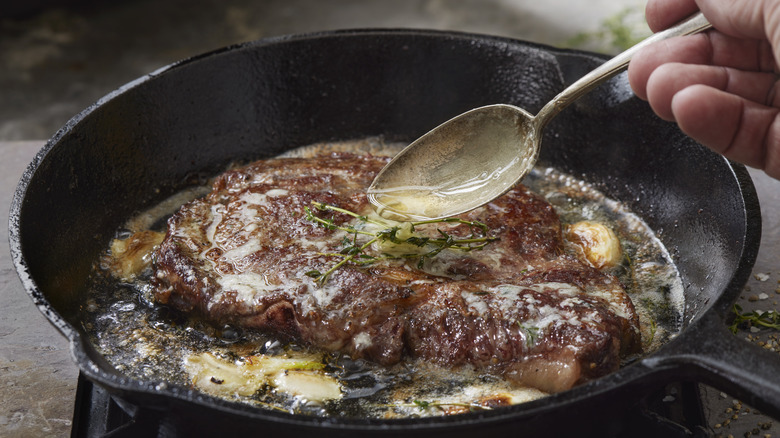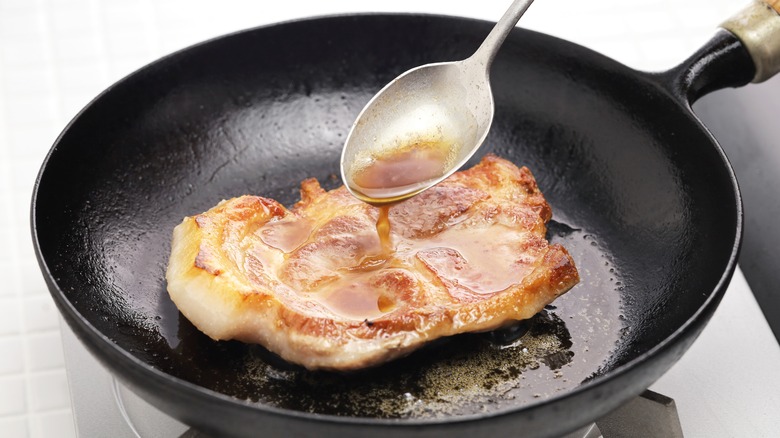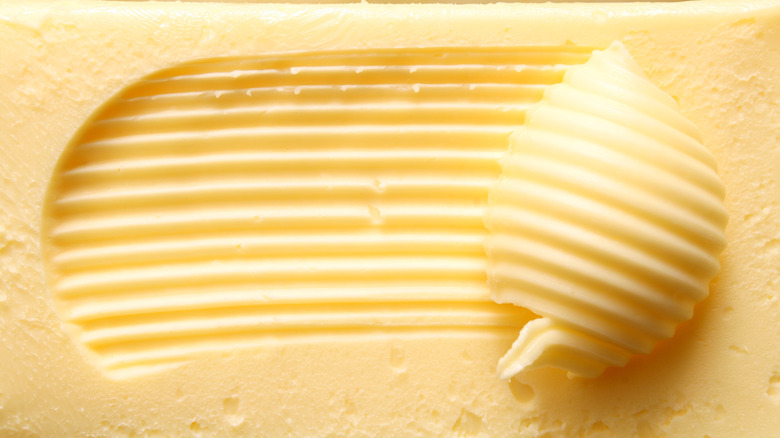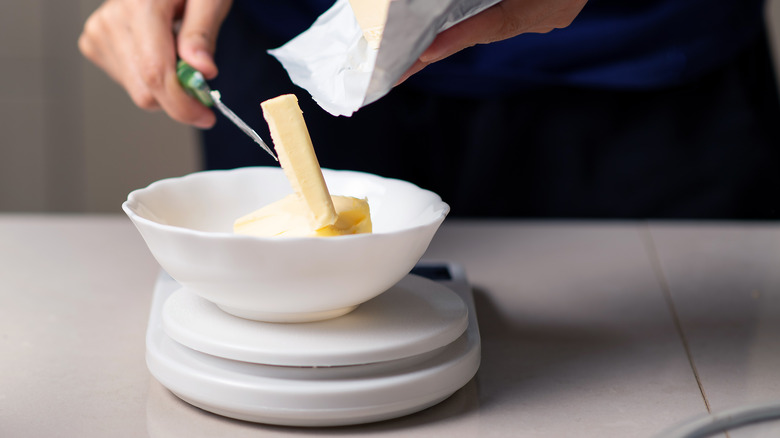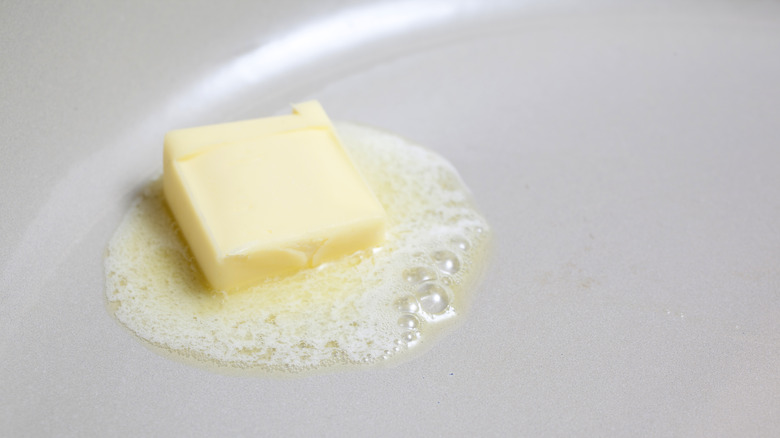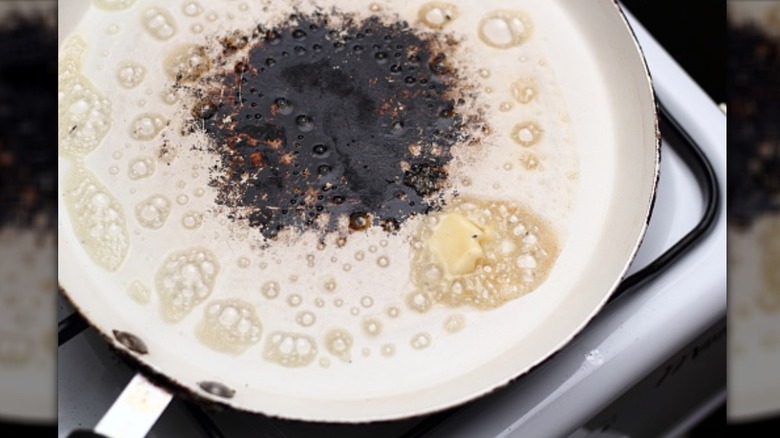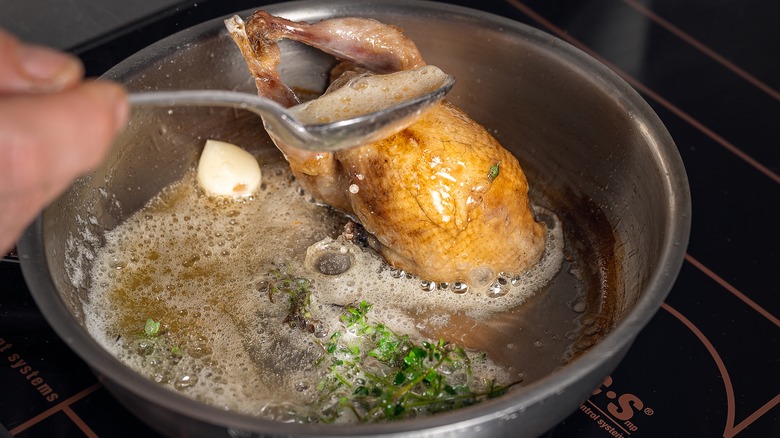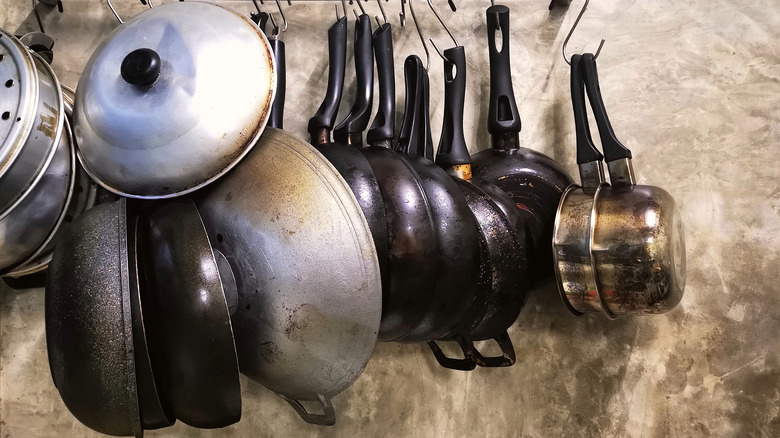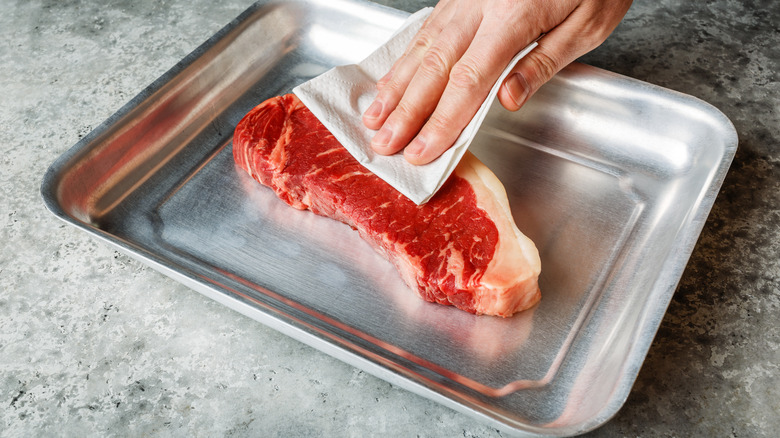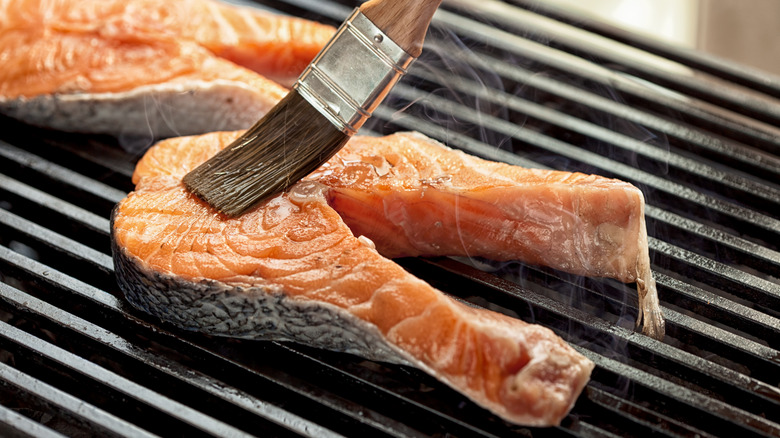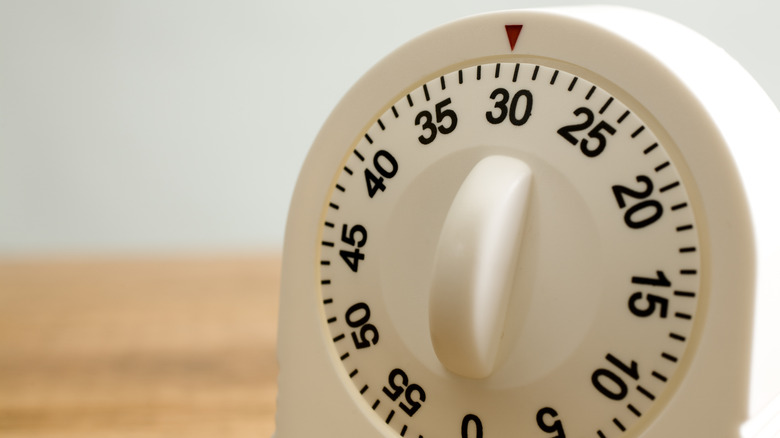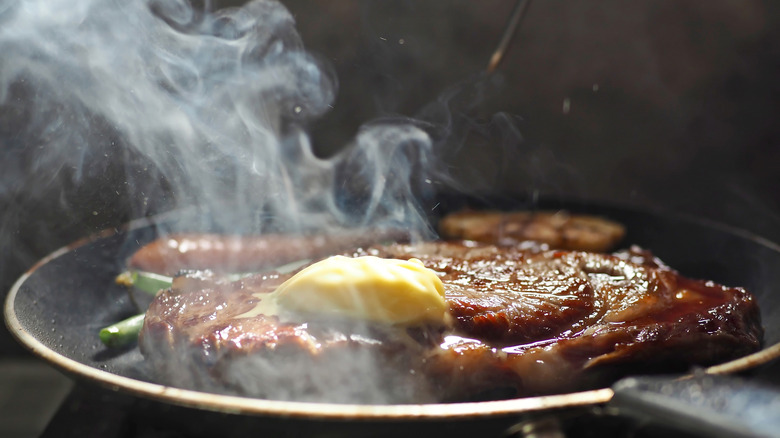11 Mistakes You're Making When Butter-Basting
If you're not ladling fragrant, deliciously seasoned melted butter over your pork chops, steak, poultry, and even fish, you're missing out on an easy technique that packs a punch of buttery goodness into each mouthful. Butter basting is a technique that adds flavor, preserves moisture, and even helps fully caramelize the surface of your food for a deeper, richer flavor.
The technique is simple, starting with melted butter seasoned with fresh herbs like thyme and rosemary and aromatics such as onions and garlic. The technique is simple. With a basting tool and a light touch, butter is slipped repeatedly across the surface of the food in the pan. The practice of and persistence with this technique rewards the chef who desires meat with an incredible depth of flavor in a perfectly browned crust or the seafood aficionado who wants the brown butter flavor without a hard sear on their fish.
Butter basting is a professional technique that even the most amateur of cooks can pull off with a little practice and a few guidelines. If you've already tried and suffered through food that tastes more like grease and less like the delectable sizzling steak you're craving, here are some mistakes you might be making.
Butter basting 101
Butter basting is the technique of placing a cut of meat or fish in a pan and continually spooning melted, seasoned butter over it while flipping the meat on a regular schedule to avoid overcooking in a hot pan.
Butter is heated in a slope-sided skillet over medium-high heat until it melts and begins to foam. Once meat or fish is added to the skillet, it's basted continuously with either a large spoon or a basting brush. The time for this varies, and the only way to determine if your meat is properly cooked is to use a thermometer. Rare steak clocks in at 120 to 125 degrees Fahrenheit, medium rare at 130 to 135 degrees Fahrenheit, and medium at 135 to 145 degrees Fahrenheit. Anything over 150 degrees Fahrenheit is considered well done.
As for poultry, it's done at 165 degrees Fahrenheit. Many chefs have revised their pork temperatures to allow for a little pink inside, but if that makes you nervous, a minimum temperature generally recognized as safe for pork is 145 degrees Fahrenheit. Fish is considered done when it flakes easily with a fork. Keep in mind and plan that all meats and fish will have some carryover cooking when removed from the pan. This is cooking that occurs due to residual heat build-up.
You're not using the right kind of butter
Rule No. 1 when it comes to butter basting: Use the best butter you can afford. Better-quality butter, like cultured butter and those found in Europe, has more fat. When it comes to butter basting and all cooking, fat equals flavor. If you've already spent lots of money on a great cut of meat or a beautiful piece of fish, it can be tempting to save some money by purchasing generic butter or whatever's on sale. Ignore this impulse and splurge.
And when it comes to splurging, make sure you use enough butter. Figure at least 4 tablespoons in the pan, with an option to add more if needed. You want enough to get a good spoonful of butter each time you baste but not so much that the final product is a big mouthful of grease. If 4 tablespoons seems like a lot, start with 3 per pound of meat or fish, and keep the butter handy in case you need more.
Using too much butter
On the other side of not using enough butter is the evil twin of using too much butter. If you've ever asked yourself, "Is there any such thing as too much butter?" the answer is yes, regarding this cooking technique.
So how much is too much? Excess butter in a skillet burns easily. If you see smoke or smell an aroma that is anything other than unctuous cooking meat, that's a good sign that excessive butter has not been moved around enough on the high-temperature pan to prevent it from burning.
Your butter may also begin to separate because you cannot properly move it around. You'll see a clear layer of butter fat as the heavier milk solids sink to the bottom of the pan. These milk solids are often what burns faster. And, yes, fat does have flavor, but fat alone without its milk-solid brethren just tastes greasy. So, instead of a creamy, deep, mouth-watering steak, you'll end up with a bitter, unpleasant, slippery cut of beef, poultry, or fish.
The butter is too cold
Many amateur cooks get excited (and hungry) while waiting for their butter to melt. This is normal, but what happens next is key. If you put your food in the pan before the butter reaches the proper temperature, you'll never achieve that delicious crust you're looking for.
Don't doom the butter-basting enterprise before it starts. Use room-temperature butter to give yourself a head start on the melting. Place the recommended amount of butter in the hot pan, and give it a moment. You are looking for the butter to melt, of course, but you're also looking for bubbles to form and pop. This foamy butter stage is what you want before your food comes anywhere near the pan. At this stage, the butter should be 250 to 275 degrees Fahrenheit, and you can check the temperature if you like.
You have another option that professional chefs often turn to, but only with room-temperature butter. If you don't want to wait for (and clean up) a separate pan of butter to melt, you can also toss in a couple of tablespoons of butter into the pan where you initially seared your steak or pork. This is a bit of a gamble, as cold butter can bring the temperature down and slow the melting, and a pan that's too hot can instantly burn the butter. But if time is short and you're familiar with the technique, it's an option.
Your butter is too hot
As with the too much/too little butter debate, it is also possible that your butter is too hot. There is a thin line between brown butter and burnt butter, and once you cross it, you'll have no choice but to toss the entire pan of butter out and start again.
So, how do you know when you've crossed the line? At the extreme end of things, butter that is too hot will begin to smoke. Before that happens, though, butter fat and milk solids separate, leaving a greasy slick on the surface of your food. Small bits of food or the herbs and aromatics you seasoned the butter with may also begin to color and char. It's possible to baste with brown butter but make no mistake. It's impossible to disguise the taste of burnt butter, and your steak will suffer for it. Learn that lesson, and start again.
Basting butter isn't seasoned
If you've spent any time watching competitive cooking shows, one thing sends chefs home instantly: serving raw chicken. The other thing that gets a chef sent packing? Unseasoned food. But here's the secret: Baseline "seasoning" is just salt and pepper. And even chefs with a culinary school education get it wrong now and then.
It's important to layer your seasoning. Season the meat or fish before you cook it, and season your butter. You can better control the salt level in your basting butter by choosing unsalted butter at the grocery store (the best you can afford, remember?). The salt per stick of butter can vary by as much as 300 milligrams, which can make a difference. So start with unsalted, and season your butter to taste.
A good rule of thumb is that your butter should not actually taste salty. Salt should be used to bring out the rich, creamy notes of the milk used to make the butter. In addition to salt, consider adding spices such as black pepper and red pepper flakes. Herbs like rosemary or thyme will release their oils into the butter and add another level of flavor to food. And don't forget to season the food before you put it in the pan. Hearty cuts of meat like steak can take a hefty helping of salt. Pork, chicken, and fish require a lighter touch, but don't neglect to season evenly before cooking.
Choosing the wrong pan
Butter basting is best completed in a good-quality skillet that can handle the high temperature required. Standard non-stick from the grocery store aisle won't cut it for this technique. And, it needs to be large enough to accommodate your food, with high sides that prevent spills.
Cast iron is a classic choice. These heavy-duty kitchen workhorses can handle and hold high temps for an extended period. They do require additional care in the form of thoughtful cleaning and occasional re-seasoning. Aside from the seasoning issue, cast iron is versatile and works on all stovetops, including induction stoves, on the grill, or around the campfire.
Another excellent choice is carbon steel. Carbon steel pans are the gold standard of professional chefs, even if they are uncommon in the professional kitchen. Their rarity is due to their sometimes-exorbitant price tag. However, if you can rustle up the cash, these pans can handle both high heat and delicate food with ease and without the weight of cast iron. They require a period of "breaking in," which is essentially seasoning over time and with consistent cooking. Of course, you can also season the pans to hurry this process along. Some chefs skip the line, melting butter and herbs in a saucepan while their steaks grill, then letting the finished, juicy product rest on a platter with the butter mixture poured on top. This method removes last-minute basting and does not require a special pan for high heat.
Your food is wet
Just as soggy bottoms have no room in pastry, wet food and butter-basting are a bad match. If you slap a wet steak into a pan filled with foaming butter, the best result you'll get is a constellation of splatter burns on your forearms caused by moisture reacting with burning fat.
Moisture on the outside of the food you're butter basting prevents the Maillard reaction. This reaction occurs when the sugars and amino acids are hit with heat, causing the crispy, flavorful brown exterior that the finest steakhouses seem to have mastered. If you haven't removed all of the moisture from the exterior of the meat or fish, the food simply steams in the pan as the water evaporates against it, and no crust will form.
This is the easiest of the potential mistakes you're making when butter basting to fix. Grab a paper towel and use it to blot all moisture from the food. This might be an extra step that you're tempted to eliminate when time is tight, but resist the urge. Those extra 30 seconds are the difference between a heavenly meal and a lackluster and bland one. Even if your meat seems dry, let it come to room temperature out of the packaging. Then pat dry again with a paper towel before seasoning and cooking.
Not using the correct tool
A chef might be only as good as their last plate of food, but the way those plates come together relies on something that plenty of home cooks overlook: kitchen tools. Kitchen tools make quick work of hard jobs, and they are indispensable when recreating chef-worthy dishes and challenging techniques.
This is true when it comes to butter basting, but there is good news. You have three main choices of tools, and they all get the job done. You can choose whichever works best for you. The most common utensil for professional chefs is a spoon. Many chefs keep a favorite spoon in their knife kit and guard it ferociously. It's usually a tablespoon size or larger, with a deep bowl for scooping butter (but not so deep that it won't release liquid easily).
Another tool is a standard butter-basting brush. Pastry chefs use these to put egg washes on pastries for a shiny finish, but butter-basting pros know they deliver an even layer of melted butter across the surface of the food. A downside is that these tools can be drippy and messy, and there is a chance that some butter will make it off the brush and onto the stove. The final option for basting is a basting bulb. This is most notable at the Thanksgiving table, basting a bird until its skin is a crackly, crispy golden hue, but it also has its place for everyday butter basting.
Basting at the wrong time
Your butter bubbles have popped, and it's properly seasoned. Your steak is dry, seasoned, and at room temperature. You pop it in the pan and start furiously scooping butter over it, flipping it every 10 seconds. Do you wonder why, even though the flavor is incredible, a crust never formed?
The timing here is everything. If you flip your steak too soon after it hits the skillet, it doesn't have time to form the initial crust. No matter the cook on the meat (unless you are going for a blue steak, in which case butter basting isn't really the move), let your steak cook for two to three minutes per side (and five to 10 for poultry) before basting. This allows a crust to form, sealing in the steak's juices.
If you don't allow that crust to form, the water in the butter will evaporate, steaming the food. It would be the same reaction as putting a wet piece of food in the hot butter. So no matter how impatient you might be, set a timer and wait until a crust has formed on both sides before you begin to baste. But don't wait too long. If the crust is too firm and fully sealed, then the butter won't be able to penetrate into the muscle fibers of the meat. Instead of creating a juicy piece of food, the butter will simply pool atop it.
You're basting too much
Basting before the meat is browned and the butter is at the right temperature might be the beginning of the end for your meat, but basting too much seals the coffin when it comes to getting the desired results. Once again, adding too much moisture in the form of butter defeats the purpose of the process. The butter should be lovingly layered onto the food, continuing the process of gradually adding flavor and texture. If you baste to excess, though, your food is, once again, steamed.
So, how do you know when enough is enough? Since you've paid careful attention to your butter's quality, amount, and temperature, it's time to listen to what your food tells you. After the first initial sear, the crust on the bottom may look dry. Baste and keep going.
Butter that continues to cook after it comes to the proper temperature takes on a nutty aroma. If that aroma starts to smell acrid, it's likely burning. Lower the heat and add more butter (unless, of course, it's too late. Then abandon ship and start over). Finally, use a fingertip to test for doneness. You might need to wear a glove if you haven't yet built an asbestos-like protective layer as chefs do, but this is an easy way to test the meat's temperature. If the surface is soft, keep basting. If it's firm with just a little give? It's likely ready to go, so pull out your thermometer and check.
